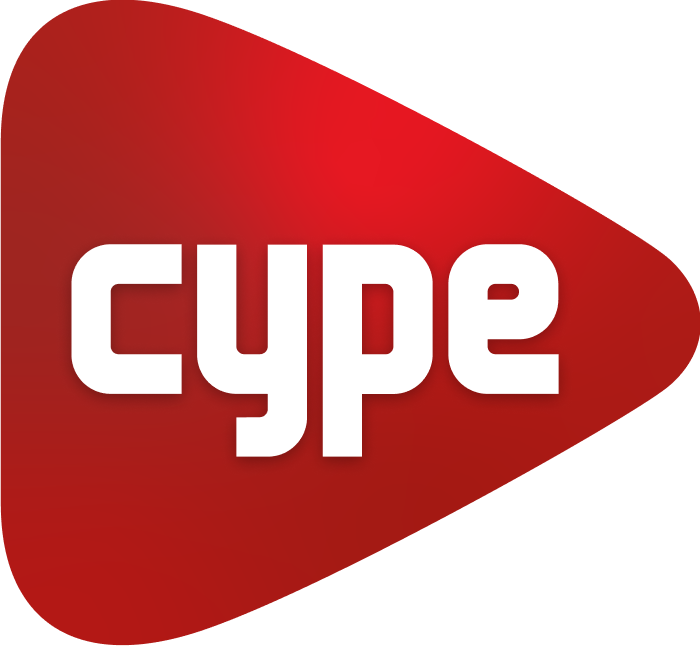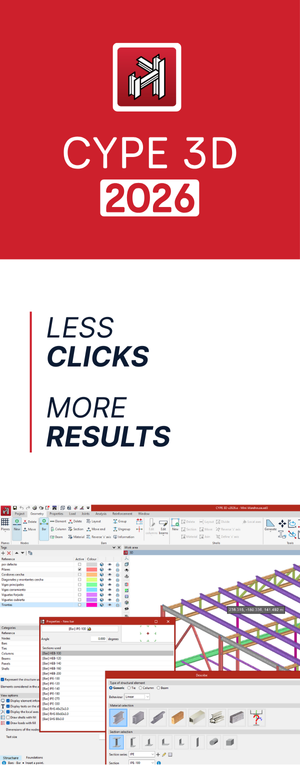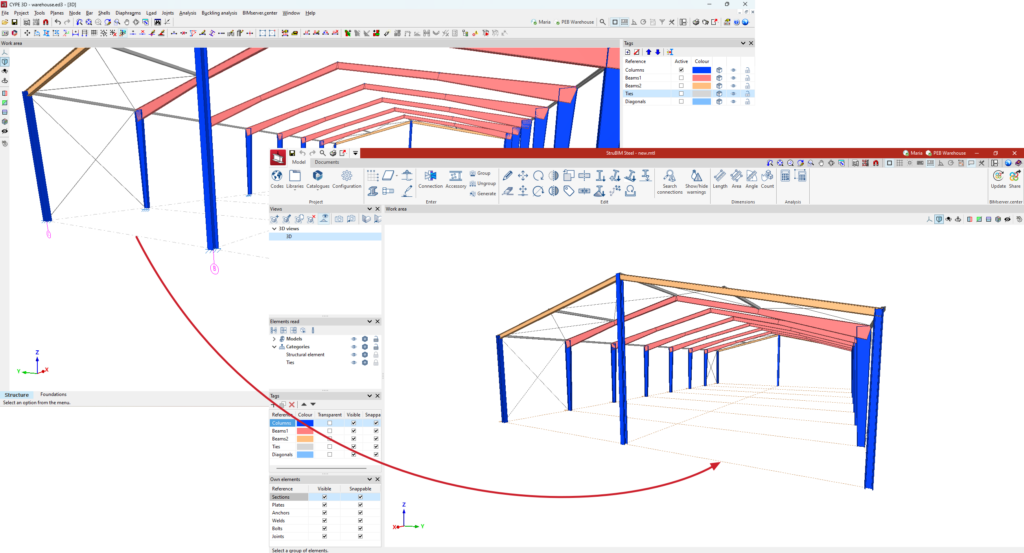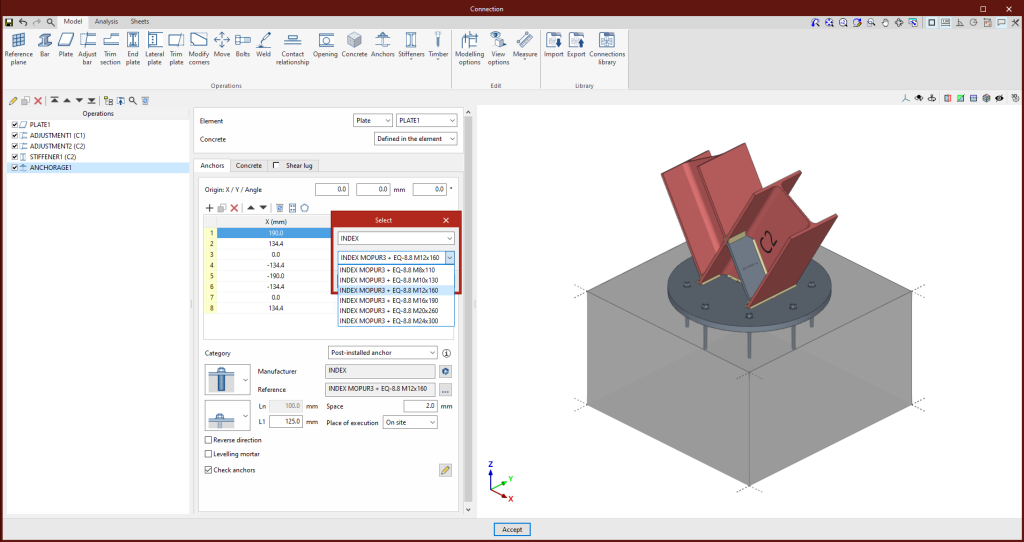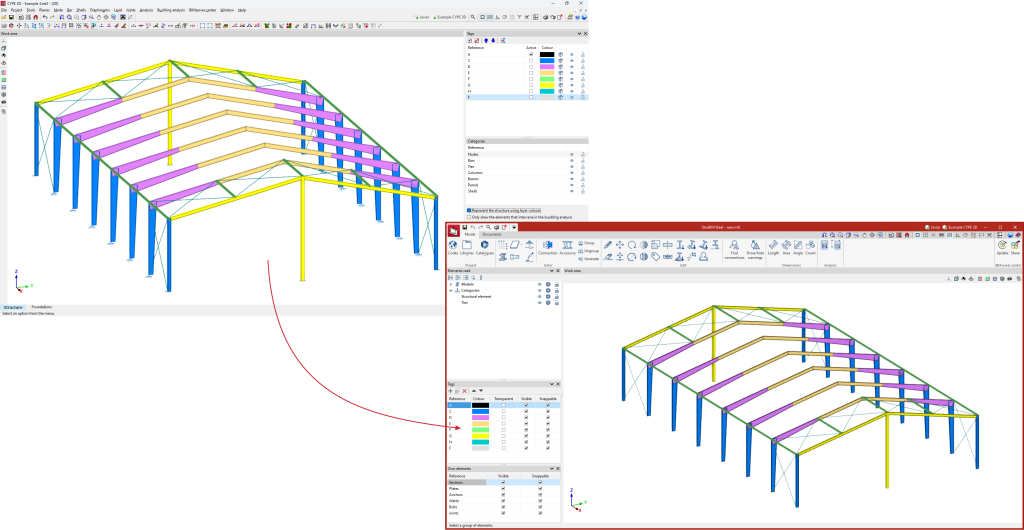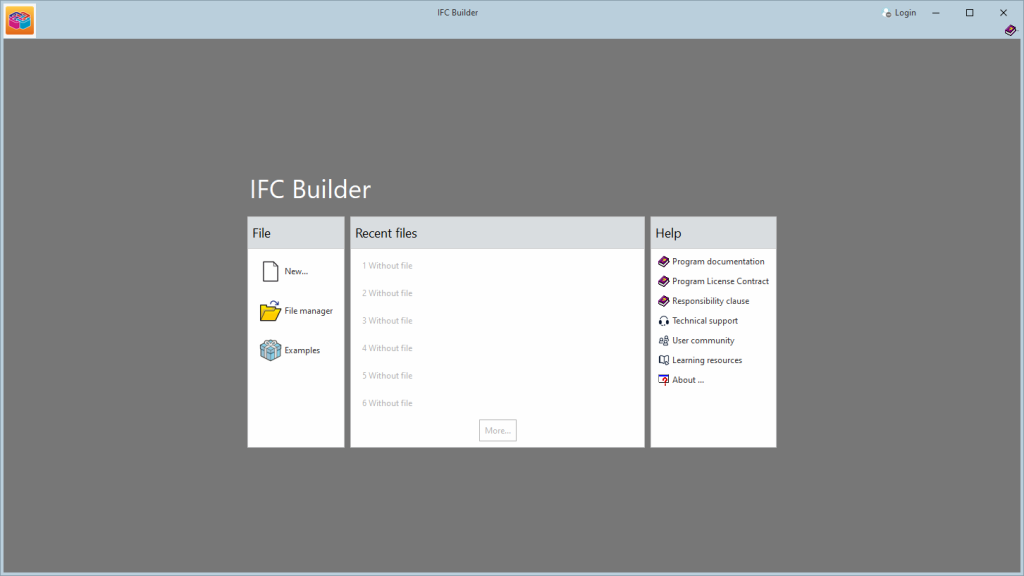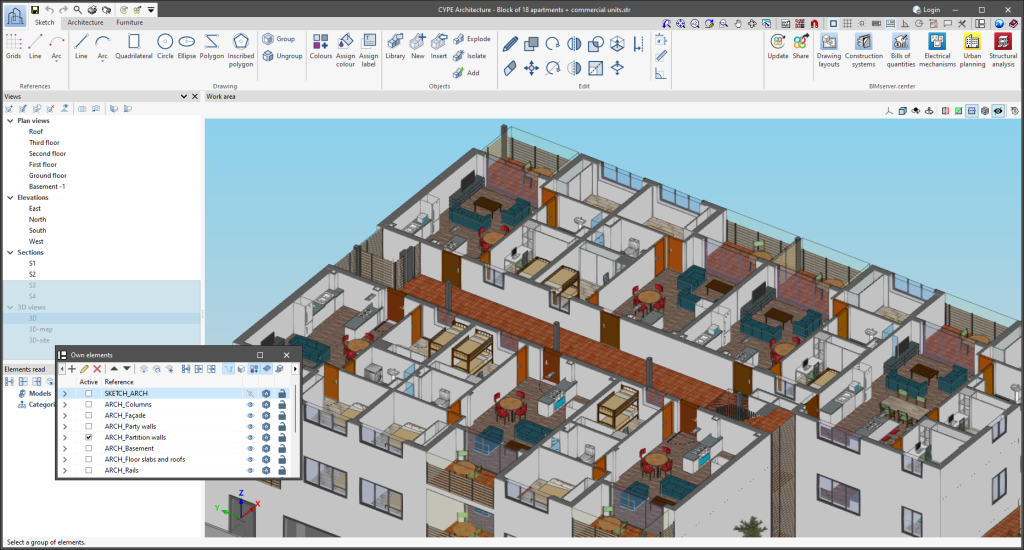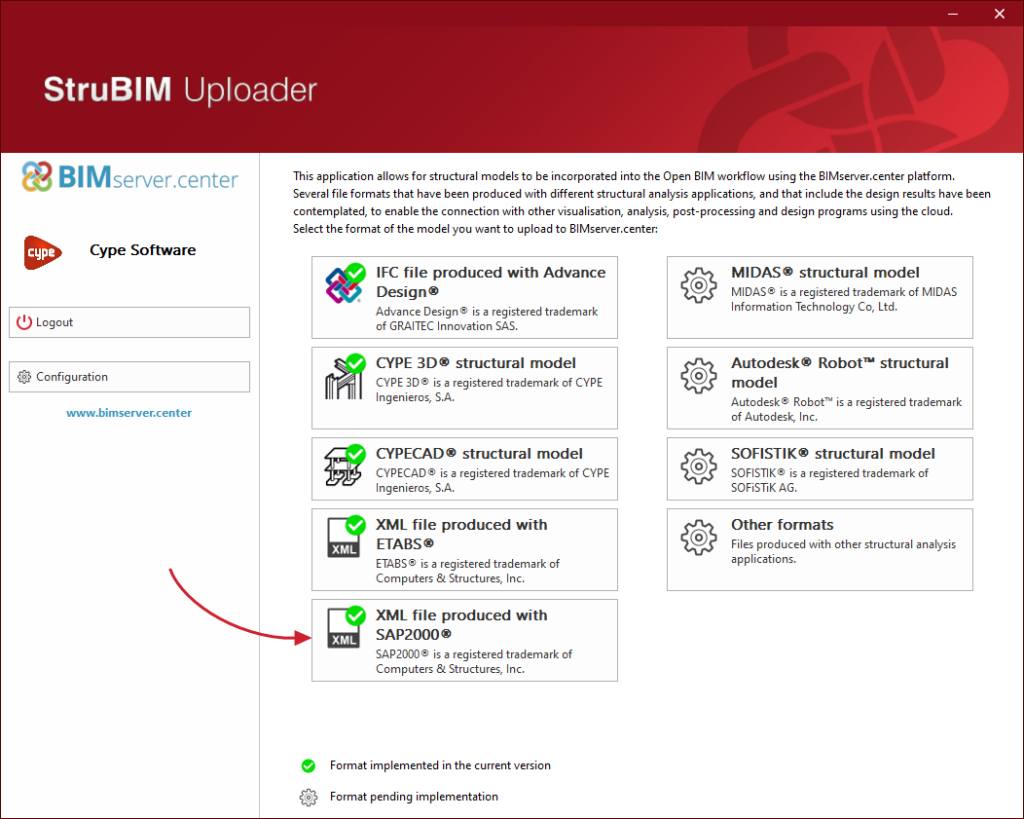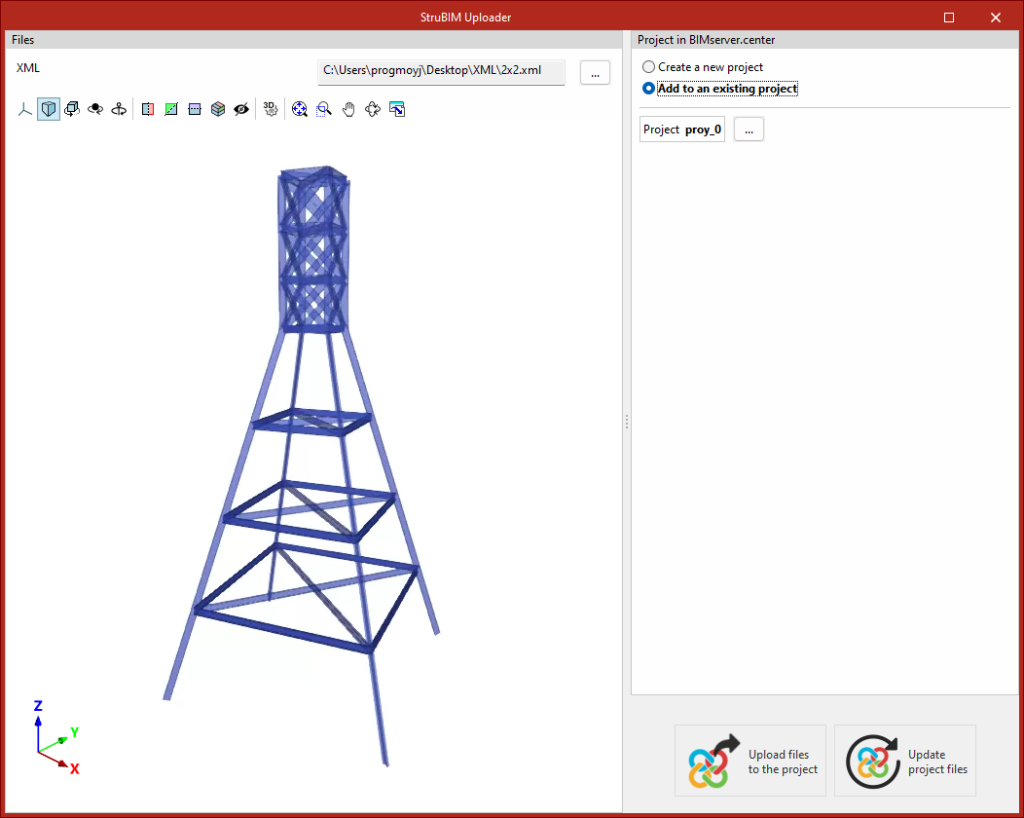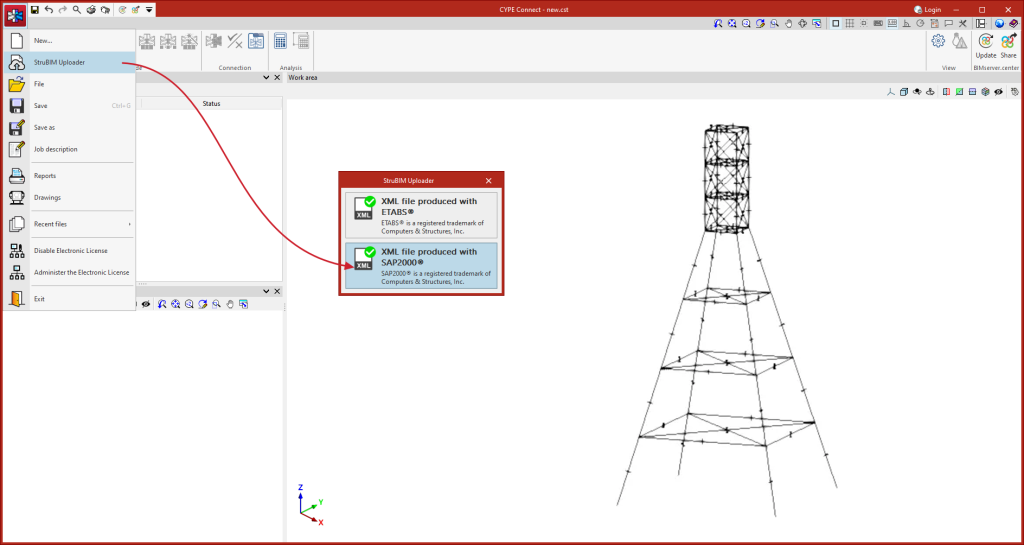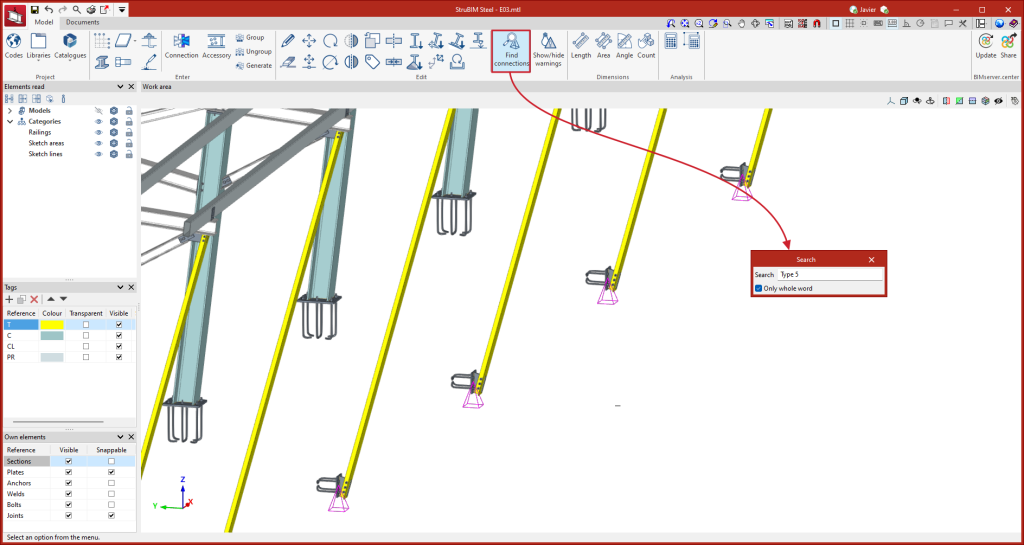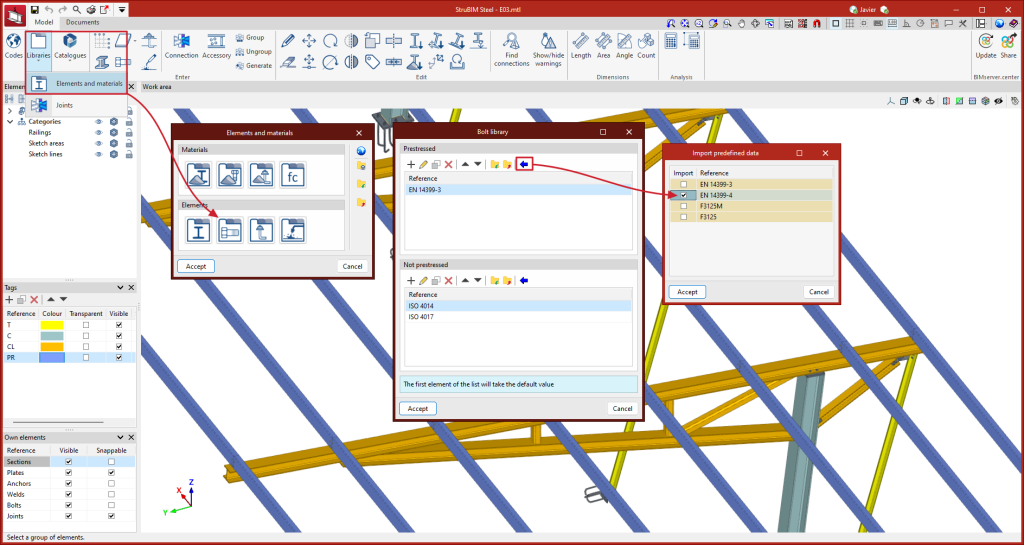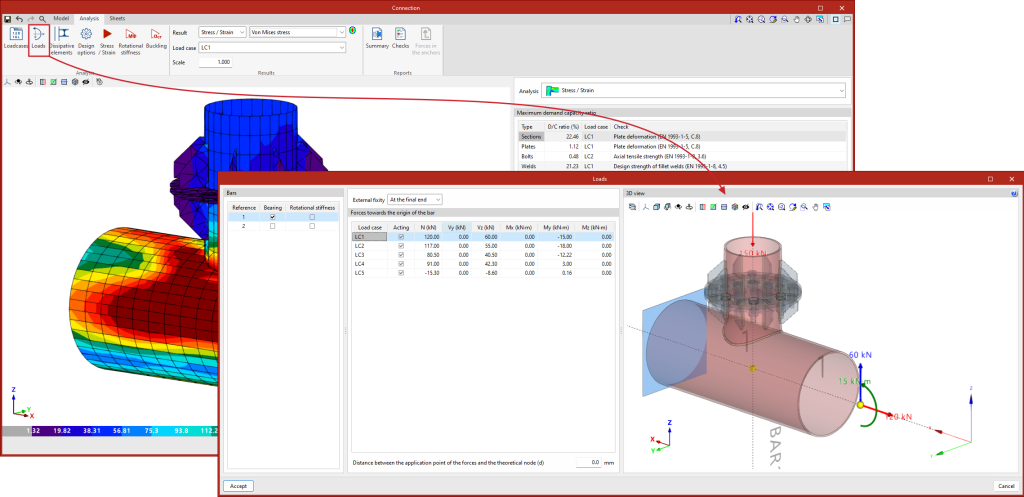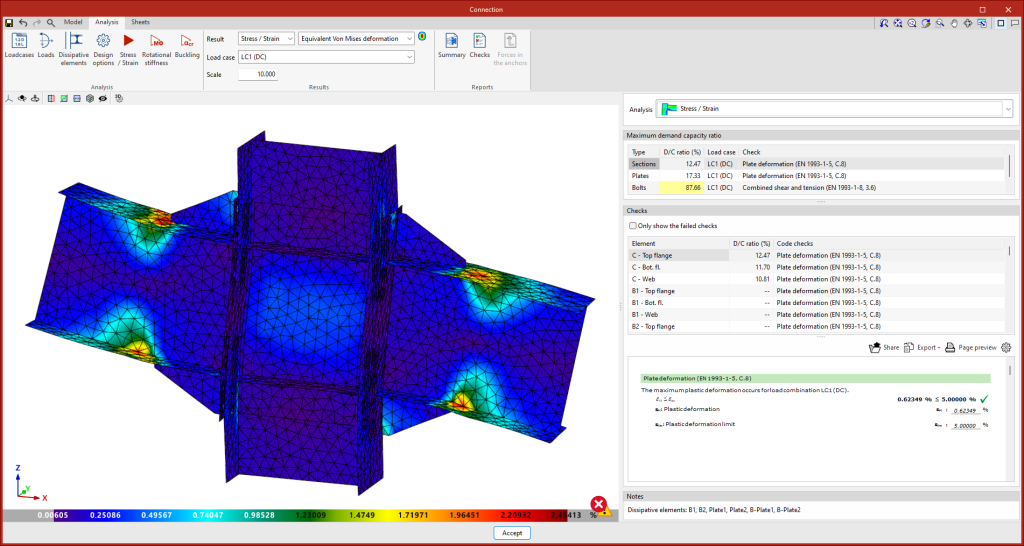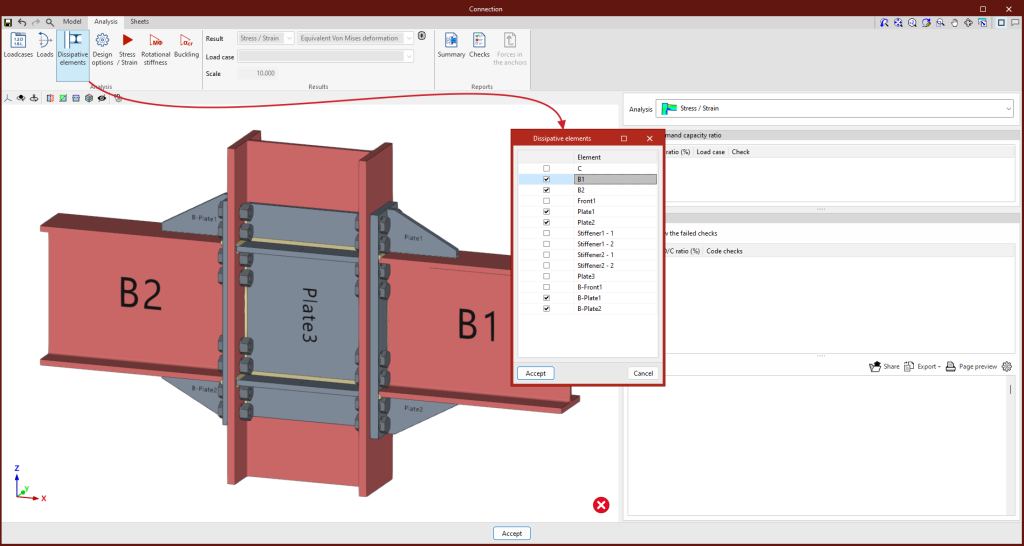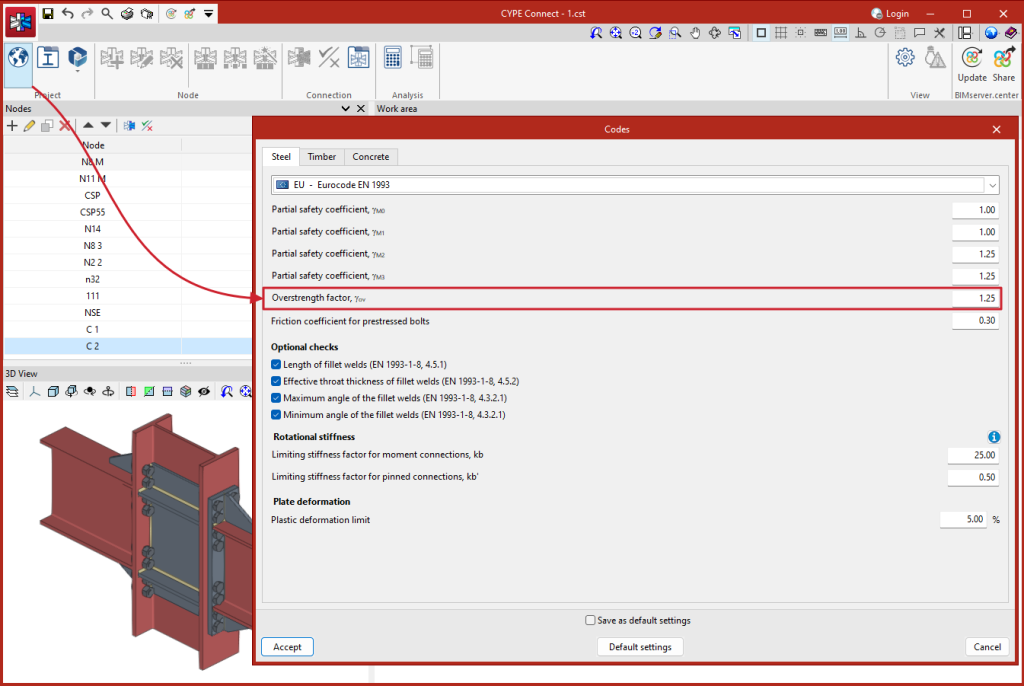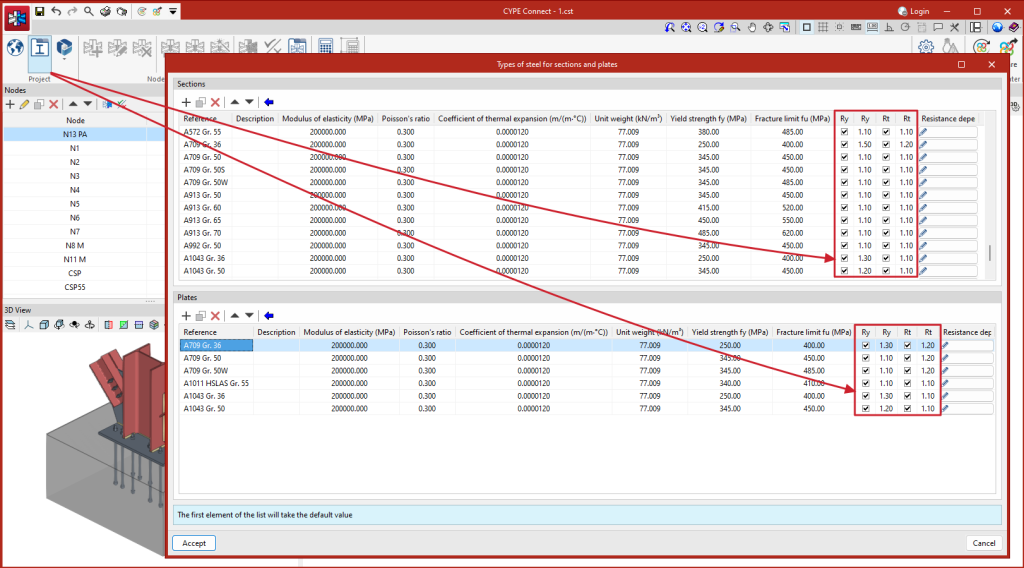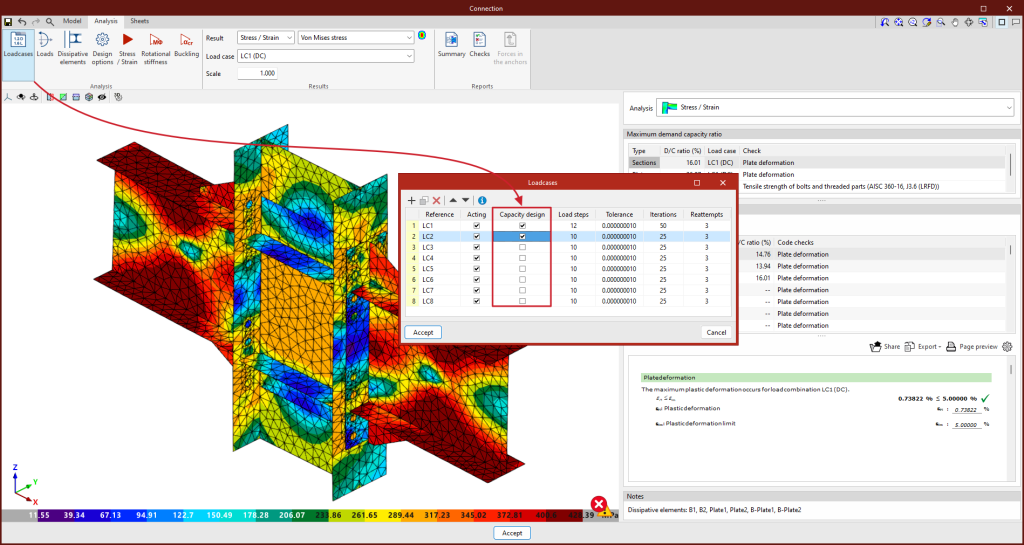Update history
StruBIM Steel
Importing the grid defined in CYPE 3D
- Published on
- 2025.d
New design models for bars
In the connection analysis model, one of the bars is set as the load-bearing element, unless a baseplate has been defined. The remaining bars are connected to this element, on which the loads are applied.
Up until version 2025.d, the bars connected to the load-bearing element had no external links, allowing users to define forces in the direction of each axis and moments around each axis.
This is the default model and the one used in previous versions. The end of the bar has no external links, allowing the six forces to be defined.
- N - Vy - Vz - Mx - My - Mz
This is the default model and the one used in previous versions. The end of the bar has no external links, allowing the six forces to be defined. - N - Vy - Mz
This model defines loads in the XY plane. The end of the bar is constrained for displacement in the z-axis and rotation in the y-axis. - N - Vz - My
This model defines loads in the XZ plane. The bar end is constrained for displacement in the y-axis and rotation in the z-axis. - N - Vy - Vz
In this model, the end of the bar is constrained for rotation and no moments can be inserted.
These new models are useful for dealing with different structural situations. For example:
Case 1
The hollow section bar is hinged in the structural model and connected by a single bolt. If the unrestrained model is used, an unstable mechanism can be generated (Case 1 - A). By changing the load model to N - Vy - Vz, the local model of the connection resembles the connection conditions in the global model of the structure (Case 1 - B).
Case 2
Two angles are connected, where one acts as a load-bearing element and the other receives a tension applied at the centre of gravity of the section. If the unrestrained model is used, the eccentricity between the load and the connection of the load-bearing section generates a penalising moment (Case 2 - A). By changing the loading model to N - Vy - Vz, a more balanced stress distribution between the two sections is achieved (Case 2 - B).
Case 3
The eccentricity of the diagonal bar generates a moment that penalises the haunch. In this case, the displacement out of the plane formed by the beam and the diagonal is constrained, so the local model of the connection is more similar to the global model by selecting the N - Vz - My model (Case 3 - B).
- Published on
- 2025.d
INDEX brand chemical anchors for concrete fixings
In CYPE Connect and StruBIM Steel version 2025.c, INDEX brand chemical anchors for concrete fixings have been incorporated as concrete fixing elements in baseplates.
These elements are checked in accordance with the criteria in EN 1992-4:2018, based on the data provided in the ETAs (European Technical Assessment) of these anchors.
- Published on
- 2025.c
Improved export/import from CYPE 3D to CYPE Connect and StruBIM Steel
Version 2024.f changed the way bars were exported and imported between CYPE 3D and CYPE Connect and StruBIM Steel from an IFC format to an exchange file in JSON format. As of this version, the bars of the sections supported by the connection editor were exported.
Now, as of version 2025.c, all other sections supported by StruBIM Steel will also be exported and imported, in addition to the tag assignment that the bars had in CYPE 3D.
- Published on
- 2025.c
Links to the CYPE website in the apps help menu
In version 2025.c, new options have been added to the "Help" menu of all CYPE apps, providing direct links to key resources on the CYPE website. These options make it easier to access to useful information and Technical Support, improving the overall experience of using the program.
The new options are the following:
- Technical support: This link provides information on the different ways of contacting the CYPE Technical Support team to clarify any queries, obtain customised assistance and solve any problem related to the apps.
- User community: This option provides access to the CYPE user community, where users can share experiences, ask questions and discuss solutions with other professionals using the same tools. This community encourages the exchange of knowledge and best practices, helping to make the most of the program's features.
- Learning resources: This link leads to a collection of learning resources, such as tutorials, manuals, videos and articles, designed to help you understand and use CYPE apps more efficiently. These materials are designed for all levels of experience, from beginners to advanced users, and are an excellent source of information to expand skills and technical knowledge.
These new additions make it easier to access information and provide the necessary support to improve the users' experience with the apps and to encourage professional development.
- AcouBAT by CYPE, Arquimedes, Continuous beams, CYPE 3D, CYPE Architecture, CYPE Connect, CYPE Connect Classic, CYPE Construction Systems, CYPE Cost Estimator, CYPE Gas Supply, CYPE Sewerage, CYPE Water Supply, CYPECAD, CYPEFIRE, CYPEFIRE FDS, CYPEFIRE Hydraulic Systems, CYPEFIRE Pressure Systems, CYPEHVAC, CYPEHVAC Radiant Floor, CYPEHVAC Schematics, CYPELEC, CYPELEC Distribution, CYPELEC Electrical Mechanisms, CYPELEC MULTILINE, CYPELEC Networks, CYPELEC PV Systems, CYPELUX, CYPEPLUMBING, CYPESOUND, CYPETEL, CYPETEL Wireless, CYPETHERM BRIDGES, CYPETHERM EPlus, CYPETHERM HYGRO, CYPETHERM Improvements, CYPETHERM LOADS, CYPEURBAN, IFC Builder, Open BIM Analytical Model, Open BIM Cable Routing, Open BIM Layout, Open BIM Model Checker, Open BIM Quantities, Open BIM Site, Open BIM Switchboard, Portal frame generator, Punching shear verification, StruBIM Box Culverts, StruBIM Cantilever Walls, StruBIM Deep Beams, StruBIM Embedded Walls, StruBIM Shear Walls, StruBIM Steel
- Published on
- 2025.c
Transparent preview in dockable windows
In version 2025.c, the preview for moving dockable windows within the apps has been improved. Now, when dragging a dockable window, the preview of its docked position is displayed transparently, allowing a clearer view of the underlying work area.
This new feature makes it easy to find the optimal location for each dockable window without obstructing important elements or losing sight of relevant project information. It also provides a smoother and more modern visual experience, aligned with best practices in user interface design.
- Published on
- 2025.c
Importing structures from an XML file generated by SAP2000®
As of version 2025.c, Sap2000® structures can be imported into CYPE Connect and StruBIM Steel.
An XML file containing all the tables of the model definition and the bar force tables (ANALYSIS RESULTS > Element Output > Frame Output) must be exported from SAP2000®.
The structure can be imported via StruBIM Uploader or directly into CYPE Connect and StruBIM Steel.
In StruBIM Uploader, by selecting the "XML file produced by SAP2000®" option, users access the file selection panel and select the BIMserver.center project, where the information will be uploaded.
After exporting to BIMserver.center, in CYPE Connect or StruBIM Steel, only the job needs to be created from that BIMserver.center project.
In CYPE Connect and StruBIM Steel, this can be imported directly via direct access to the StruBIM Uploader.
The bars and the forces in the bars by combination are imported.
- Published on
- 2025.c
Connection search tool
In StruBIM Steel version 2025.c, a new tool is implemented that will allow users to search for connections.
When launching the tool, a panel appears where the user can enter the reference of the connection they want to search for; and all the connections that match the text entered will be highlighted, either fully or partially, depending on whether the "Only whole word" option is activated or not.
- Published on
- 2025.c
New EN 14399-4 bolt series
- Published on
- 2025.c
Load representation in a 3D view
- Published on
- 2025.c
Analysing connections with energy dissipation elements, for capacity design
In version 2025.c, CYPE Connect and StruBIM Steel include the necessary tools to carry out the analysis of connections with dissipative elements. These tools can be used to design connections for earthquake-resistant structures in which energy dissipation is foreseen through the formation of plastic hinges, either in one of the elements of the connection or in the bars linked to it.
In the "Analysis" tab, a tool has been added to select the dissipative elements, offering users the option to choose between sections and plates. The material properties of the dissipative elements are transformed in the load cases marked as "Capacity design", considering the effects of material overstrength.
For Eurocodes and similar standards, the program will request the overstrength coefficient of the material, ?ov, which amplifies both the yield strength and the ultimate strength of the dissipative elements. For American standards such as AISC360, NSR10, NTC-2023, among others, and other similar standards, the program will include in the material library the specific overstrength factors for each type of steel, Ry and Rt.
To analyse the connection for the over-resistance in dissipative elements, it is necessary to select not only the dissipative elements but also the "Capacity design" types of load cases in the list of load cases.
This new implementation allows users to design the connections so that the capacity of the connection is larger than that of the dissipative element while considering the over-resistance. In these cases, dissipative elements will experience large plastic deformations, which makes it difficult to converge the model, therefore, another relevant parameter in dissipative elements is the slope of the plastic span.
As detailed in the calculations manual, the constitutive law for plates and sections follows a bilinear model, where the slope of the plastic span is tan-¹(E/1000). For dissipative elements, in addition to incorporating the over-resistance coefficient as a multiplier of the yield stress, the slope of the plastic span is adjusted. In these elements, for a deformation of 5%, the stress will reach the elastic limit of the material, amplified by the over-resistance coefficient (?ov or Ry, depending on the applied standard) and by the resistance reserve coefficient due to strain hardening, which is equal to 1.1. This slope, greater than tan-¹(E/1000), contributes to improve the convergence of the analysis.
- Published on
- 2025.c
Implementation. TCVN-5575:2012 (Vietnam)
"Steel Structure – Design Standard: TCVN-5575:2012".
Implemented in CYPE Connect and StruBIM Steel for checking bolted and welded steel connections.
- Published on
- 2025.c
